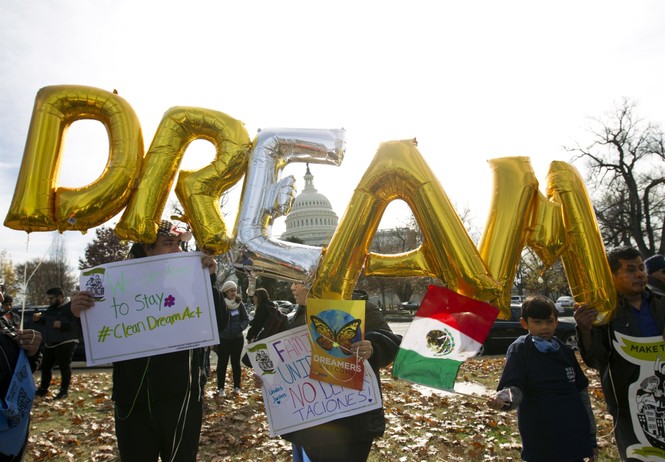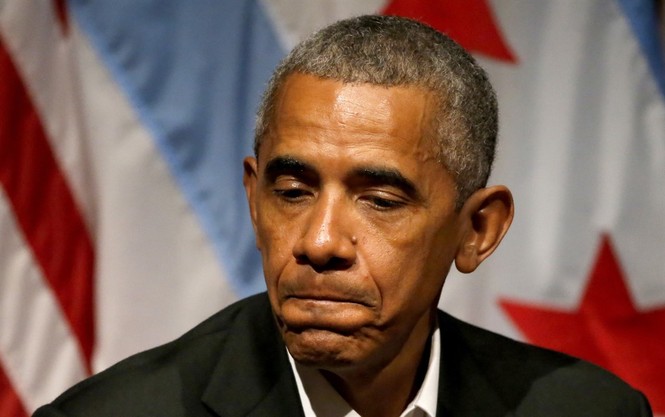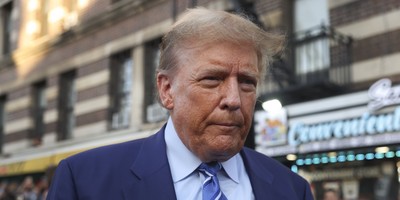An executive order enacted six years ago is once again the focal point of discussion for immigration reform in the United States. Here’s what you need to know about the order known as the Deferred Action for Childhood Arrivals (DACA), its impending expiration, and what potential solutions are on the table.
What Is DACA?

Deferred Action for Childhood Arrivals, more commonly known as DACA, was established by former President Barack Obama through executive action in June 2012 after Congress failed to pass the DREAM Act. The program provides certain individuals brought to the U.S. illegally as children temporary protection from deportation, as well as work permits. In order to be granted deferred action, individuals must meet a number of specific requirements (via the Department of Homeland Security):
- Were under the age of 31 as of June 15, 2012;
- Came to the United States before reaching your 16th birthday;
- Have continuously resided in the United States since June 15, 2007, up to the present time;
- Were physically present in the United States on June 15, 2012, and at the time of making your request for consideration of deferred action with USCIS;
- Entered without inspection before June 15, 2012, or your lawful immigration status expired as of June 15, 2012;
- Are currently in school, have graduated or obtained a certificate of completion from high school, have obtained a general education development (GED) certificate, or are an honorably discharged veteran of the Coast Guard or Armed Forces of the United States; and
- Have not been convicted of a felony, significant misdemeanor, three or more other misdemeanors, and do not otherwise pose a threat to national security or public safety.
Despite what some may think, currently, DACA does not provide these individuals with lawful status or a path to citizenship; it merely delays their deportation for two years. The Department of Homeland security can end or renew an individual’s deferred action at its discretion.
The application fee for the DACA program is around $495 per person. The cost is the same to file a renewal application. Those in favor of DACA believe this fee is too high. However, when you consider how much it costs for immigrants to come here legally, the price doesn’t seem quite so steep.
Recommended
In September, President Trump kept one of his biggest campaign promises and ended the DACA program - with a six-month enforcement delay. That means Congress has until the end of March 5th to figure out a fix. However, Trump has reportedly said he will consider extending the deadline if an agreement is not reached by then.
Who Is Affected by DACA?

While many often refer to DACA recipients as DREAMers, it’s important to note that not all DREAMers are DACA recipients.
There are an estimated 3.6 million DREAMers, or illegal immigrants brought to the U.S. as children, living in our country. Only about 800,000 of them are a part of the DACA program.
The states with the largest populations of DACA recipients are California and Texas, with 222,795 and 124,300 recipients respectively as of March 2017. You can check out the rest of the states’ breakdowns here.
Lawmakers on both sides of the aisle are typically sympathetic to these individuals since they were brought to the U.S. illegally as children. For many DREAMers, who are now young adults, America is virtually the only home they’ve known; they go to school here, they work here, they have families here.
In September, the Trump administration stopped accepting new applications for the DACA program, and, in October, it stopped accepting renewal applications for past recipients. Those with existing work permits will maintain their protected status until their permits expire.
If a DACA deal is not reached by March 5th, an estimated 983 illegal immigrants will lose their protected status each day. That translates to about 30,000 people a month.
What Is the DREAM Act?

DREAMers got their name from the DREAM - or Development, Relief, and Education for Alien Minors - Act, an immigration proposal which has been introduced a number of times since 2001. The last official vote was held in 2010.
According to the most recent version, introduced by Republican Sen. Lindsey Graham in July 2017, the bill would grant lawful permanent resident status to illegal immigrants who:
(1) have been continuously physically present in the United States for four years preceding this bill's enactment; (2) were younger than 18 years of age on the initial date of U.S. entry; (3) are not inadmissible on criminal, security, terrorism, or other grounds; (4) has not participated in persecution; (5) have not been convicted of specified federal or state offenses; and (6) have fulfilled specified educational requirements.
What Are the Problems With DACA?

There are a number of issues with the DACA program, the first being legality.
As mentioned earlier, DACA was established through an executive order by former President Barack Obama after Congress repeatedly failed to pass the DREAM Act. Critics of DACA believe this was a gross misuse of power; the president should not be able to circumvent Congress whenever he doesn’t get his way and unilaterally enact major policy changes. Not to mention, our Constitution gives Congress, not the president, absolute authority over immigration matters.
Townhall’s Guy Benson breaks it down further (emphasis mine):
Those of us who objected to this approach warned that abusing executive authority represented poor and instantly-reversible (and in some cases constitutionally-suspect) governance. The next guy could just swoop in and undo entire wide-ranging policies with a single stroke of the pen, we argued. We were correct. Rather than doing the hard work of brokering a serious compromise on Capitol Hill to resolve certain challenges with permanency, legitimacy and bipartisan buy-in, Obama opted for a risky shortcut. This was short-sighted and irresponsible, at the very least.
In others words, Obama knowingly created this mess. The former president even said, repeatedly, that instituting an immigration policy like DACA through executive action would be unconstitutional. Of course, he did so anyway. And in 2014, he tried to do so again with the Deferred Action for Parents of Americans and Lawful Permanent Residents program, or DAPA.
Back when Trump first announced he would be ending the plan, CNN's Chris Cuomo, in a conversation with the Justice Department's Sarah Isgur Flores, also admitted that DACA has been "legally dubious" from the start.
That same week, Democratic Sen. Dianne Feinstein of California, too, conceded that DACA was founded on “shaky legal ground,” and expressed the need for reform achieved through the right means.
The other - and arguably bigger - issue with DACA is the message it sends to the rest of the world: we’re soft on illegal immigration, and you don’t need to go through the proper channels to stay here and receive protections from our government.
This is a huge slap in the face to those who worked hard - and waited years - to come here legally. Even worse, it encourages more illegal immigration. And, despite what Democrats want you to think, not all DREAMers are outstanding individuals. Just see here and here.
“The flawed implementation of the President’s blanket deferred action program has created a loophole that allows dangerous criminals who came here illegally - even known gang members - to stay in the country,” North Carolina Senator Thom Tillis said after gang member and DACA recipient Jesus Rangel-Hernandez was charged with four counts of first-degree murder. “The USCIS needs to immediately start performing detailed criminal background checks to prevent similar tragedies from occurring in the future.”
While these kinds of cases are surely the exception - most people who come here are simply looking for a better life - why chance allowing criminals to stay in our country and risk the safety of our citizens by keeping this incredibly flawed program in place?
What Are the Proposed Solutions?

President Trump isn’t just looking to solve the DACA problem, he wants comprehensive immigration reform. At the end of January, the White House sent its official framework on immigration to Congress. It calls for:
- A permanent fix to DACA, which includes a path to citizenship for 1.8 million illegal immigrants currently residing in the U.S.
- An end to chain migration
- An end to the visa lottery program
- Funding for increased border security, including the wall
In his first State of the Union address, Trump offered more details on his plan to move to a merit-based system.
Of course, a pathway to citizenship for over one million DREAMers, a major concession which upset a sizable portion of the Republican base, isn’t enough for Democrats.
House Minority Leader Nancy Pelosi called the framework “a part of the Trump Administration’s unmistakable campaign to make America white again.”
“[This] is an act of staggering cowardice which attempts to hold the DREAMers hostage to a hateful anti-immigrant scheme,” she added in her statement.
Sen. Chuck Schumer posted a similar statement on Twitter.
As we have been urging him to do for months, the President has finally put pen to paper to show us where he stands on immigration. Unfortunately, this plan flies in the face of what most Americans believe. 1/2
— Chuck Schumer (@SenSchumer) January 26, 2018
While @realDonaldTrump finally acknowledged that the Dreamers should be allowed to stay here and become citizens, he uses them as a tool to tear apart our legal immigration system and adopt the wish list that anti-immigration hardliners have advocated for for years. 2/2
— Chuck Schumer (@SenSchumer) January 26, 2018
Before Trump released his framework on the immigration plan, Reps. Will Hurd (R-TX) and Pete Aguilar (D-CA) introduced a piece of legislation that seems to (mostly) fall in line with what the president is asking.
The Uniting and Security America Act is a “bipartisan bill that protects DACA recipients from deportation while implementing new common sense border security measures through enhanced technology, manpower and physical barriers, where necessary.”
“This is the type of bipartisan approach that the American public wants to see,” Hurd said on CBS’s “Face the Nation.” “[T]his is the type of narrow focus that can get 218 votes and can get to the president’s desk.”
The bill currently has 53 co-sponsors on both sides of the aisle. Hurd and Aguilar are hoping for a vote before March 5, Trump’s DACA deadline.
On Monday, Sens. John McCain (R-AZ) and Chris Coons (D-DE) introduced their own immigration bill. However, unlike Hurd and Aguilar's, it fails to meet a number of the President’s demands.
The measure seeks to give DREAMers who have resided in the U.S. since December 31st, 2013 legal status and a path to citizenship - a group that will reportedly be larger than the 1.8 million people proposed in Trump’s plan.
The Wall Street Journal offers more details (emphasis mine):
Aiming to tighten border security, their bill calls for the Homeland Security Department to devise a strategy for situational awareness and operational control of the border by 2020. The bill would provide a $110 million annual grant for five years to improve coordination between border-patrol agents and state and local law-enforcement officials. It wouldn’t, however, direct any funding for border technology or the more-controversial barriers or wall that Mr. Trump wants.
The legislation also calls for clearing a backlog in the immigration-court system by hiring 55 new judges per year, as well as dozens of staff attorneys, for three years. The bill would also direct the State Department to submit a three-year strategy aimed at addressing the underlying causes of immigration from Central America to the U.S. Many Central Americans try to enter the U.S. illegally because of severe drug gang violence in their home countries.
In response to McCain and Coons’ proposal, the president sent out this warning:
Any deal on DACA that does not include STRONG border security and the desperately needed WALL is a total waste of time. March 5th is rapidly approaching and the Dems seem not to care about DACA. Make a deal!
— Donald J. Trump (@realDonaldTrump) February 5, 2018
Congressional Republicans will likely have a similar response to the bill.
With a potential deadline fast approaching, what changes are you hoping to see to our immigration system, and how would you like the president to handle the millions of "DREAMers" currently residing in our country?
























Join the conversation as a VIP Member